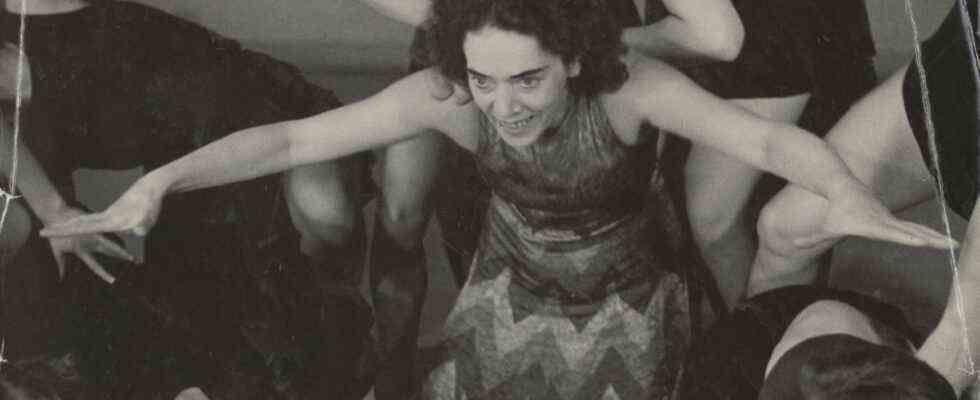The man is sitting cross-legged on a square, he looks sceptically at the camera. Behind it is a young photographer named Irving Penn, who brings the beautiful, the rich and the famous to his New York studio to look after them for the Vogue to portray. Penn devised a setting that was as simple as it was ingenious for the recordings: a narrow corner to which each of his models reacts with a body language staging. The man on the square is called Isamu Noguchi, is an American with Japanese roots, a sculptor and set designer for the choreographer Martha Graham. He posed for Penn with his head held high in 1947, but he folded his body with minimalist grace. Graham, who asked Penn to shoot a year later, was completely different: The modern dance pioneer extended her elbows and knees until she touched the walls of the corner – maximum displacement of space, maximum self-awareness and sense of mission of a daughter from a good family. In the “Global Groove” exhibition at the Folkwang Museum in Essen, the two photographs are now hanging right next to each other and document what it’s all about: intercultural exchange and transcontinental building of bridges that have changed the face of dance since the fin de siècle.
Drawings, photographs, artefacts from the turn of the century – the display value is beguiling
It is clear why the topic is popping up right now. Dance is the profession that has been practicing the whole range from cultural appropriation to knowledge transfer to the hybridization of art for well over a hundred years. Four curators have compiled an abundance of images, archive materials, films and objects in order to illustrate modern mixtures of “art, dance, performance and protest” – the subtitle of the show. The timeline provides the basic framework, with the somewhat confusing exhibition architecture tempting you to hop on chapters. The excellent catalog manual, which condenses the material and impressively profiles historical processes, provides orientation afterwards.
The show value of “Global Groove” is simply beguiling. A 40-meter-long, glittering wall of waves runs right through the first of the four exhibition halls: “Foreverago” is the name of this installation by Pae White – a vertical kimono quilt that combines historical costumes and advanced technology, East and West. It is the same with the artifacts around, all of which date from the turn of the century. Loïe Fuller’s lively serpentine dances shine from a Japanese environment, Pablo Picasso dotted the dancer Sada Yakko on paper, Auguste Rodin sketched the acts of the Cambodian court ballet on their debut in France. A little later he modeled the head of Hisa Ōta alias Madame Hanako, whose theatrical suicide scenes fascinate all of Europe. On the other side of the Atlantic, Ruth St. Denis pays homage to orientalism, from the headdress to the bell chain on the ankle.
In the service of the future: stage design elements (spider dress, snake) by Isamu Noguchi for Martha Graham’s “Cave of the Heart”, 1946.
(Photo: Cris Alexander / The Isamu Noguchi Foundation and Garden Museum / VG Bild-Kunst, Bonn 2021)
The exotic grace, as this prelude shows, is irresistible. In the Old World, it is primarily transformed through media, i.e. transferred to drawings, sculptures or photographs. With the expressive dance the phase of appropriation begins: Asian artists like the Javanese dancer Raden Mas Jodjana travel to Europe, pass on their art and their knowledge. Mary Wigman is one of Jodjana’s students and develops – keyword “witch’s dance” – to the master of a cross-fading technique that crosses influences from the Far East with expressive impulses. In the 1930s, Wigman’s student Harald Kreutzberg, on the other hand, became the midwife of Japanese Butoh, the “dance of darkness” that competed against traditional styles and structures in post-war Nippon. In the opposite direction, the Indian Uday Shankar established a kind of early Bollywood in England – thus gradually closing an earth-spanning dance cycle.
The exchange with painting, design and fashion leads to a vibrant avant-garde
The pioneering role of dance is put together like a mosaic when walking through “Global Groove”. The mutual influence of dance cultures, the exchange with painting, design and fashion – all of this leads to a vibrant avant-garde. The body art proves to be extremely changeable and dynamic: its metamorphosis is not a transitory phenomenon, but a permanent state. Thrusts in progress are always linked to social upheavals – an aspect that the exhibition illuminates rather vaguely.
Choreographers like the pioneer of postmodernism, Merce Cunningham, or the dance theater icon Pina Bausch never fall into the limelight by chance. Cunningham’s rise is taking place against the backdrop of a turbulent decade that began for the United States with the Cuban Missile Crisis and did not end with the Vietnam debacle. Pina Bausch takes on the legacy of expressive dance – via the Folkwang School – and at the same time stands for emancipation and experiment. These lines remain pale in “Global Groove”, and so the chance to write the dance emphatically into the history of society disappears. The same applies to current issues, such as K-Pop. A product like the “Black Swan” clip shot by BTS in 2020 would have belonged here because it removes dust from “Swan Lake” and exports it back to the West: the location was an Art Deco theater in LA
Nevertheless, “Global Groove” impresses as an aesthetic questioning of a past that is not so distant and yet seems far removed. The unruly and resistive flows cheerfully in the mainstream today, no one will deny the importance of collaborative approaches. Martha Graham and Isamu Noguchi are representative of numerous partnerships that thought dance forward and moved it into the future. Incidentally, Irving Penn also photographed Merce Cunningham and was married to a Wigman student. In the end, the “Global Groove” is an astonishingly familiar event.
“Global Groove” in the Folkwang Museum, Essen, until November 14; the catalog was published by Hirmer.

